![]()
![]()
![]()
Use LEFT and RIGHT arrow keys to navigate between flashcards;
Use UP and DOWN arrow keys to flip the card;
H to show hint;
A reads text to speech;
59 Cards in this Set
- Front
- Back
|
How would you multiply a monomial by a polynomial?
4x(3x² - 6x - 7) = |
i) use the distributive property of multiplication, ii) when distributing, don't forget the rules of handling exponents
12x³ - 24x² - 28x |
|
|
How would you multiply a binomial by a binomial? (x + a)(x + b)
|
x²(first) + bx(outer) + ax (inner) + ab(last)
|
|
|
What is the FOIL method?
|
Process of multiplying binomials. Start with the FIRST terms, OUTER terms, INNER terms and then LAST terms. Then simplify by combining like terms where possible.
|
|
|
Solve (x + 2)(x + 3)
|
x² + 5x + 6
|
|
|
(x + 2)(2x - 5) =
|
2x² - x - 10
|
|
|
When simplifying equations, how should you deal with exponents that are negative?
|
You should try to express them as positive by converting them to reciprocals.
|
|

Simplify
|

Divide and combine like terms. As messy as this looks, there is no additional simplification that can be done
|
|

Simplify
|
8x² - 5x + 3
|
|
|
What is an undefined fraction?
|
fraction in which you divide by 0 - there is a rule in math which states that you can not divide by 0
|
|
|
What does it mean to factor a polynomial?
|
To __find__ the greatest factor, which divides into each term
|
|
|
Factor 6x² - 10x³
|
2x²(3 - 5x)
|
|
|
When factoring polynomials, how do you factor the variables?
|
Use the variable with the lowest exponent
|
|
|
How would you convert a monomial with a variable that has a negative exponent? 7x⁻⁴
|

i) write out the monomial as a fractional operation, ii) negative power = reciprocal with pos. power, ii) simplify it
|
|
|
What is special about this expression? How is it factored? x² - 25
|
binomial which is a difference of two perfect squares;
a² - b² = (a + b)(a - b) |
|
|
Factor 4x² - 49
|
(2x + 7)(2x - 7)
|
|

What is special about this expression? How is it factored?
|
Trinomial, addition:
a² + 2ab + b² = (a + b)(a + b) or (a + b)² |
|
|
Factor x² + 8x + 16
|
(x + 4)²
|
|

What is special about this expression? How is it factored?
|
Trinomial that follows the pattern:
a² - 2ab + b² = (a - b)(a - b) or (a - b)² |
|
|
Factor x² - 8x + 16
|
(x - 4)²
|
|
|
When factoring polynomials, what can you deduce from x² ?
|
That binomials must be of the form (x )(x )
|
|
|
When factoring polynomial that do not fit any known patterns, what is the process?
|
start with the first term, the last term, then the middle term.
|
|
|
When factoring polynomial that do not fit any known patterns, what impacts the last term in the expression?
|
What two numbers __multiplied__ will equal the last term.
|
|
|
When factoring polynomial that do not fit any known patterns, what impacts the middle term in the expression?
|
What __sum__ of two terms will equal the middle term.
|
|
|
Factor: 3x² + 8x + 5
|
(3x + 5)(x + 1)
|
|
|
Factor: x² - 2x - 15
|
(x - 5)(x + 3)
|
|
|
a² - b² =
|
(a + b)(a - b)
|
|
|
a² + 2ab + b² =
|
(a + b)(a + b)
|
|
|
a² - 2ab + b² =
|
(a - b)(a - b)
|
|
|
What does it mean to factor a polynomial completely?
|
Keep factoring (pulling out) factors until nothing more can be done
|
|
|
Factor Completely: x⁴ + 3x³ - 10x²
|
x²(x - 2)(x + 5)
|
|
|
The square root sign is often referred to as a
|
radical
|
|
|
The number under the square root sign is called a
|
radicand
|
|
|
√(a x b) can be written as
|
√a x √b
|
|
|
When you have a square root of a product, it can be rewriten as
|
product of the square roots
|
|
|
A square root of a quotient is
|
the quotient of the square roots
|
|
|
Simplify the radical √48
|
4√3
|
|
|
√(a÷b) =
|
√a ÷ √b
|
|
|
√(25/49)
|
5/7
|
|
|
When operating on a radical, what is the principle root?
|
Radicals can simplify to either a positive or negative number. Both are correct, however the principle root is the positive answer.
|
|
|
7√5 + 6√5 =
|
13√5
|
|
|
How do you add radicals?
|
if the radicals are the same, you add their coefficients
|
|
|
How do you subtract radicals?
|
if the radicals are the same, you subtract their coefficients
|
|
|
How do you multiply radicals?
|
multiply the radicands, and then the coefficients
|
|
|
4√3 · 7√5 =
|
28√15
|
|
|
√60 ÷ √4 =
|
√15
|
|
|
27√60 ÷ 3√4 =
|
9√15
|
|
|
What is a complementary angle?
|
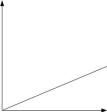
Two angles, which complement each other and total 90°
|
|
|
Two angles, which total 90° are known as
|
complementary angles
|
|
|
Two angles are complementary. One measures 3x + 10. The other measures 7x - 20. What is the value of x? What are the two angles?
|
x = 10; 40° and 50°
|
|
|
How do you divide radicals?
|
divide the radicands, and then the coefficients
|
|
|
What are supplementary angles?
|
Two angles, which supplement each other along a straight angle, and total 180°
|
|
|
Two angles, which total 180° and lie along a straight angle are
|
supplementary angles
|
|
|
Two angles are vertical. They measure 2x + 20 and 4x - 10. What is the measure of each angle?
|
x=15; 50°
|
|
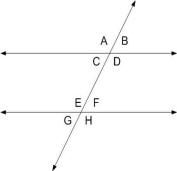
Angle C and F are known as
|
alternate interior angles; are acute and equal
|
|
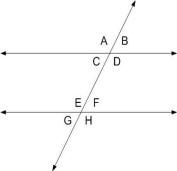
Angle D and E are known as
|
alternate interior angles; are obtuse and equal
|
|
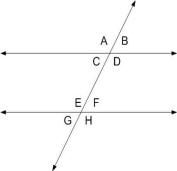
Angles A and H are known as
|
alternate exterior angles and are equal in measure
|
|
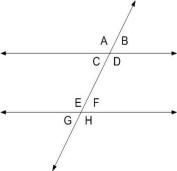
Angles A and E are known as
|
corresponding angles and are equal in measure
|
|
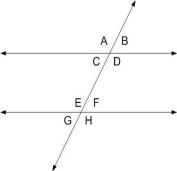
Angles A and B are also known as
|
adjacent angles. they are also supplementary because they lie across a straight angle
|
|
|
How do you find the sum of interior angles of a polygon?
|
(n - 2)180, where n is the number of sides
|

